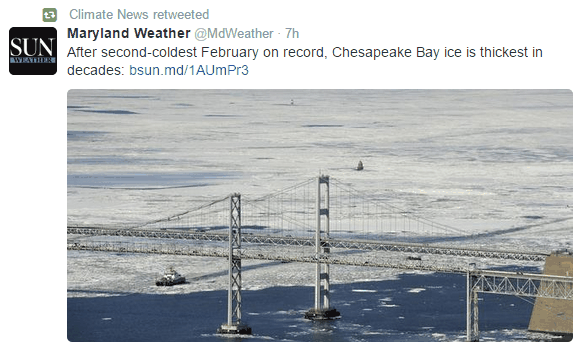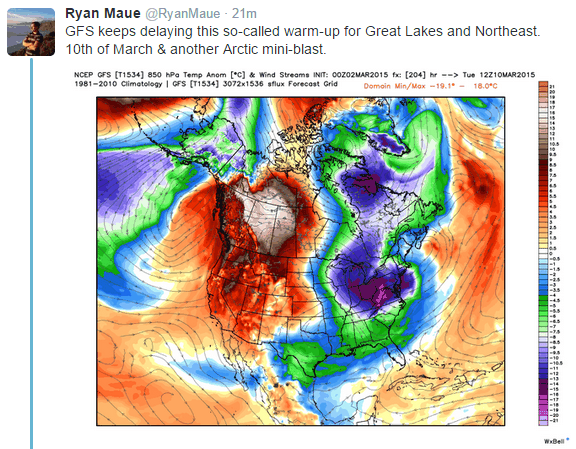Three years ago, ingenious scientists predicted that DC cherry trees would bloom in February
Could cherry blossoms one day be blooming in winter? – The Washington Post
We just had our second coldest February on record, and Chesapeake Bay is frozen over.
With lots more record cold on the way.
You have to wonder how these people are able to tie their own shoes, much less find their way to their ivory tower to write and peer-review this kind of garbage.




Even without going to the sources, you do realize that the quote you posted says “In future decades…” and it was written in 2012, right?
So you believe in fortune tellers , do you pa32r ?
Irrelevant question of course, but no. I’m pointing out that Mr. Heller is poking fun at a prediction that was not made. Try to follow along.
Tony is poking fun at soft targets. It’s like watching Charlie brown, Lucy, and the football. You start giggling the minute Lucy starts tossing the ball around, and you don’t need to wait for the fail.
https://www.youtube.com/watch?v=055wFyO6gag
Mr. Heller may be pointing out that the last two winters are making the forecast look less likely at present. The graph lines are pointing downward for the last couple of years. It’s equally likely it could be very cold, as it now. The prediction is not scientific at all. It’s a guess that fits the beliefs of the one doing to the predicting.
I was just looking at some cherry trees here in Mid – North Carolina Only one tree had swollen tips and they looked black and dead.
Normally we have the forsythia and Daffys out by now.
Anecdotally, in these times, spring can come early but not this year – maybe.
Here in Northern England, our Daffys were coming up in January [early] but are not flowering – yet.
In parks and on roundabouts, I can see snowdrops and crocuses together and we’ve not had anything like the cold being suffered over State’s side. The recent few years, a increase in sea temps and the maritime influence being enhanced by what could only be described as ‘warm’ sea temps up in Summer to 19-20ºC more especially in the western approaches, damn that Atlantic conveyor – or not, because I like big warmy – it’s so natural.
Winter of 2013, went on until May and what would we Brits talk about, if it [climate, weather, the seasons] was just all the same?
Our summers have been very cool in Mid North Carolina too.
In 2013 we only had one day at 95F (35C) and a few days that barely reached 90F (32C). Last summer we had one day at 97F (36C) and a few days that barely reached 90F (32C). Normally summer hits the 90s for a couple of months with frequent days over 95 and even 100F (38C) For the last two summers my white clover, a cold season plant intolerant of high temps, did well blooming all summer instead of looking like a very dead crispy critter. That is a first in the twenty years I have lived here. The clover useually doesn’t make it through the summer without drying up and blowing away even if we have plenty of rain.
Hmm, I quite like life south of the Mason Dixie and – in particular the people – no angles or, high falutin airs [NYC]. Charlotte, is a most agreeable and charming place, however the [summer] weather is a bit warm for my liking, seems to be cooling though:o)!
Maybe, I meant, should have said humidity, for I spent some time in Arizona Nr Flagstaff and found the temps much more suitable – erm….. for me, at any rate.
Normally our snowdrops and crocuses would be starting to come out now, and they don’t mind poking through a bit of snow. They can’t make it through a 3ft snow pack though.
A bit of a tall order for little flowers!
Just took a stroll out to the road to get my mail, and my ever growing rabbit population has eaten the bark off all of the smaller trees up to about a foot off the ground. Snow has covered everything else, and they practically run you over foraging for what is left.
The earliest blooming date on record was March 15th, 1990 – 25 years ago. Not looking much like that will happen this year, does it?
You do realize that I have been following this for 36 years, and they repeat the same crap about “future decades” every year? Right?
Comprehend much?
2015 is in the decade following 2012, right? You do realize that things that temporally follow some specific date tend to be in the future with regards to that date, right? And that future can be divided into decades, right? I mean, I guess it’s also fair to suggest he was talking about perhaps billions of years from now, since those are also future decades, right?
It’s always nice when a statement turns out to contain no information at all, right?
RE: Peak Cherry Blossom Bloom dates.
The National Park Service has a web page with a link to their blooming data from 1921.
Historic List of Cherry Blossom Festivals and Blooming Periods for the Yoshino and Kwanzan Varieties.
http://www.nps.gov/cherry/cherry-blossom-bloom.htm
Peak Bloom date for Yoshino Cherry
1921 March 20
2014 April 10
The Cherry Blossom Festival also keeps track on their “Bloom Watch” webpage for the Yoshino Cherry Trees
http://www.nationalcherryblossomfestival.org/about/bloom-watch/
SG, Something of great interest.. from JoNova.
http://joannenova.com.au/2015/03/historic-documents-show-half-of-australias-warming-trend-is-due-to-adjustments/#comments
Compensate properly for UHI and it is quite likely there has been NO REAL WARMING in Australia, or very little, since 1900 !!
“…there has been NO REAL WARMING in Australia, or very little, since 1900 !!”
That is not a surprise. Check out the bottom decadal graph (Koppen is plant based climate system)
http://www.sturmsoft.com/climate/suckling_mitchell_2000_fig2_3.gif
Frank Lansner identified the fact that coastal areas are influenced by the PDO and AMO — Ocean Air Affected stations (“OAA”) — Therefore they have very different temperature profiles compared to interior trends — Ocean Air Shelter stations (“OAS”). By taking advantage of this the global temperature can be shaped into the desired Hokey Stick by adding and dropping stations. The blue line is the temperature readings not influenced by the oceans. Notice the nice ~80 yr sine cure for the interior temperatures. A similar ~88 yr Gleissberg solar cycle was found by Dr Feynman in the ancient Nile River records.
http://hidethedecline.eu/media/AORIT/SUM/9.gif
I disagree. All of Australia’s warming is due to adjustments.
Quite probably, yes. 🙂
Maybe I should have said that once UHI is compensated for, (in the correct direction), there is quite probably a cooling trend in Australia since 1900. 🙂
Would not be surprised if UHI adjustments were correctly applied, other inappropriate adjustments such as TOBS reversed, the resulting global temperature trend is either flat or cooling.
I used to be able to access raw station data from NASA, as well as photos of the actual sites. When I selected true rural stations in the Midwestern US, there was a slight cooling trend over the past century.
Australia’s record was set in 1960.
http://ca.reuters.com/article/domesticNews/idCAKBN0LT25520150225?sp=true
Steve
I see you’ve got a nomination at the Bloggies 2015, in competition with WUWT amongst others.
You got my vote.
“…find their way to their ivory tower to write and peer-review this kind of garbage.”
Synchronized head nodding is not that difficult.
Can you imagine how the guy fourth from the left would feel if he is turning his head side to side, while all his clones are nodding up and down.
Would be a really serious ego blunter for him !
He would no longer … “belong” !
ostrichised !
I have been a professional arborist, a “tree surgeon”, for some 17 years. Before that I was an orchardist for 15 years and raised mostly stone fruits. One of the biggest crops in our area are sweet cherries and that’s an orchard crop of my expertise. Anyone who has raised cherry trees professionally, as well as stone-fruits in general, knows that they need a period of winter dormancy after they drop their leaves in the winter. Each species of stone-fruit, as well as many different varieties within each species, need different periods of cold dormancy in order to wake up, as well as set flowers and fruit. Stone fruits DO NOT wake up just because the weather starts to warm up! They generally wake up after they’ve gotten their needed number of cold hours and not before. If a winter happens to be unusually warm and those trees don’t get their cold hours of dormancy then they will wake up in spring, but significantly LATER, maybe a month or 6 weeks later than average. This is because there is a mechanism in trees which delays wake-up because the trees are, in effect, expecting more cold hours so they hold off their wake-up with the hope of accumulating more. And then if they don’t get their cold hours and wake up late they will either not flower at all or flowering will be very sparse. In fact, I could argue that the reason trees wake up much earlier is because they have gotten their cold hours, thus that would mean that the winter was actually COLDER so they got their compliment of cold hours early! If those cherry trees which woke up early present a full compliment of flowers then it’s certain that their cold-hour requirements were filled. So the notion that cherry trees will wake up earlier because warm weather is occurring earlier is complete nonsense and promoted by either those who are ignorant of the biological processes of stone-fruits or are trying to pull the wool over the general public.
Mopping the sweat from their brows, I’m sure. Why, normally it would take a twelve-man crew almost the whole week to get that many blossoms watched. You can’t just hire some untrained schlub from Iowa out of a corn field & expect this level of productivity.
It’s federal and therefore mandatory union crews. I’m surprised that it was only 12. I can only assume that the foremen, supervisors, inspectors, shop steward, safety officer and contract compliance officer were not counted.